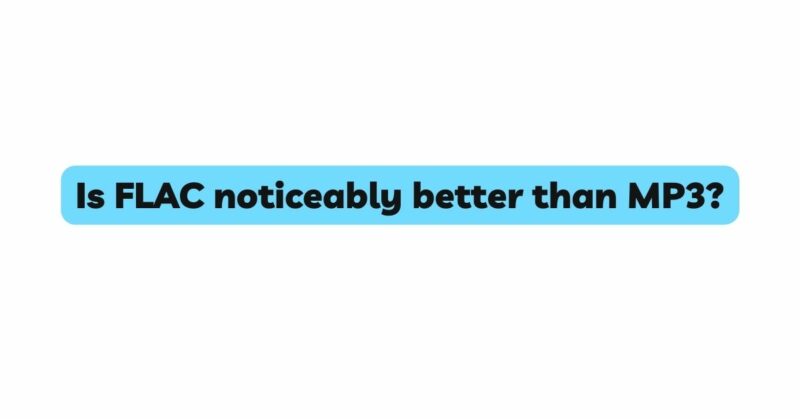In the intricate world of digital music formats, the FLAC (Free Lossless Audio Codec) vs. MP3 (MPEG Audio Layer III) debate stands as a quintessential battleground for audiophiles and casual listeners alike. At the heart of this debate lies a fundamental question: Is FLAC truly distinguishably superior to MP3 in terms of audio quality? This article embarks on a comprehensive exploration, delving into the technological intricacies of both formats, the nuances of human auditory perception, and the practical implications that shape the preference for one over the other.
Understanding FLAC and MP3
Before delving into the perceptual aspects, it’s vital to comprehend the technical foundations of FLAC and MP3. FLAC is a lossless compression format, meticulously preserving the entire range of audio data while efficiently reducing file size. This results in pristine audio reproduction, identical to the original source. In contrast, MP3 employs lossy compression, sacrificing certain audio details deemed less perceptible to the human ear in order to achieve significantly smaller file sizes.
Perception of Sound Quality
The human auditory system is an intricate mechanism capable of detecting a broad spectrum of frequencies and dynamic ranges. However, the question that looms large is whether the average listener can effectively discern the minute differences in audio quality between FLAC and MP3 formats. The answer hinges on several factors, including listener expertise, equipment quality, and listening environment.
Audiophile Perspective
Audiophiles, known for their acute sensitivity to sonic details, are often proponents of FLAC due to its lossless nature. Their finely tuned ears and high-end audio setups allow them to perceive subtle nuances that might elude less discerning ears. Studies conducted with trained listeners in controlled environments have shown that in specific conditions, these individuals can distinguish between FLAC and MP3, thus lending credibility to the notion of FLAC’s superiority.
The Role of Equipment and Environment
The gear used for playback plays a pivotal role in the perception of audio quality. Audiophile-grade headphones, speakers, and amplifiers are engineered to reproduce sound with exceptional accuracy, potentially revealing the finer intricacies of FLAC audio. Furthermore, the acoustic properties of the listening environment can either enhance or mask these distinctions. A well-treated room might amplify the differences between FLAC and MP3, while ambient noise and room acoustics can diminish their perceptibility.
Objective Measures of Audio Quality
Analyzing the technical specifications of FLAC and MP3 provides insight into their potential differences. FLAC’s lossless compression ensures that no audio information is discarded during encoding, whereas MP3’s lossy compression involves a trade-off between data reduction and audio fidelity. This difference is often quantified using bit rates, where higher bit rates indicate more detailed audio reproduction. However, even at higher bit rates, MP3 may introduce compression artifacts that impact sound quality.
Subjectivity in Perception
The subjective nature of human perception adds layers of complexity to the FLAC vs. MP3 debate. Research indicates that individual preferences, familiarity with the music, and expectations significantly influence how listeners perceive sound quality. This subjectivity is further compounded by the placebo effect, where knowing the file format beforehand might subconsciously predispose listeners to prefer one over the other.
Real-World Listening Environments
In contrast to controlled listening tests conducted in laboratories, real-world listening scenarios introduce a myriad of variables that can dilute the perceived differences between FLAC and MP3. Portable devices, noisy surroundings, and suboptimal audio equipment may hinder the average listener’s ability to appreciate FLAC’s fidelity over MP3. As a result, the claim of FLAC’s noticeable superiority might be more challenging to substantiate in everyday scenarios.
Practical Considerations: Storage and Compatibility
While FLAC’s potential to offer superior sound quality is evident, it comes at the cost of significantly larger file sizes compared to MP3. This poses challenges in terms of storage space and compatibility, especially in an era of streaming and on-the-go music consumption. MP3’s smaller file size ensures efficient streaming and broader device compatibility, addressing practical concerns that often override nuanced sound quality differences.
Conclusion: Bridging the Divide
The question of whether FLAC is noticeably better than MP3 is a multifaceted exploration of science, psychology, and practicality. The perceptual superiority of FLAC over MP3 is not universally experienced due to variations in listener expertise, equipment quality, and listening environments. While FLAC’s lossless compression does ensure that no audio detail is compromised, the average listener’s ability to perceive these nuances in real-world contexts remains a matter of debate.
Ultimately, the choice between FLAC and MP3 is a matter of individual preference and prioritization. Audiophiles and enthusiasts seeking the utmost audio fidelity might gravitate toward FLAC, relishing its potential for enhanced sonic detail. However, for the majority of listeners, MP3’s convenience, compatibility, and efficient streaming make it a more practical choice. The FLAC vs. MP3 debate exemplifies the convergence of technology and artistry, where sound quality is woven into a tapestry of perception, preference, and convenience.


